Step into biblical tales where mortals glimpsed the divine, exploring the mystery and transformation behind seeing God's face.
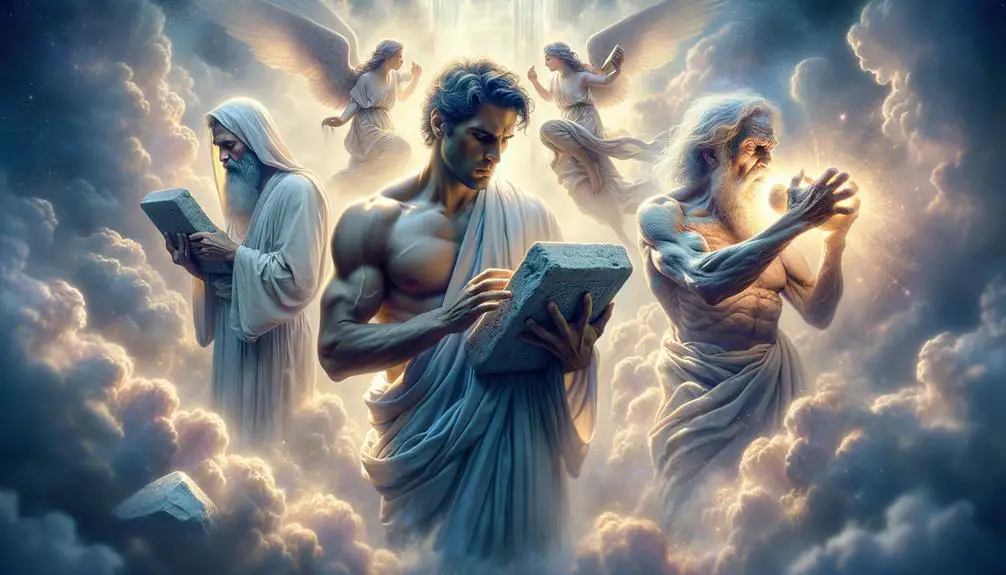
Who Saw God's Face in the Bible
In the tapestry of biblical narratives, the encounters where mortals gazed upon the divine visage are threads that shimmer with mystery and awe. You might find yourself intrigued by the audacity of Moses asking to see God or the wrestling match between Jacob and a heavenly being at Peniel.
From Isaiah's heavenly vision to John's Revelation, these moments invite you to ponder the nature of such divine encounters. What did they truly see, and how did these visions transform their lives and faith? Let's explore the shadows and the light of these profound experiences, where the seen and unseen weave together.
Key Takeaways
- Moses is renowned for his encounter with God on Mount Sinai, where he received the Ten Commandments.
- Jacob wrestled with a divine being, an event that led to his renaming as Israel, symbolizing a direct encounter with God.
- Isaiah's prophetic commission was marked by a vision of God's glory in the temple, signifying a divine encounter.
- Ezekiel and Daniel experienced visions of divine beings and heavenly realms, contributing to theological insights and fulfilling specific roles in God's plans.
Moses' Encounter With God

One of the most pivotal moments in biblical narratives is Moses' encounter with God, wherein he receives the Ten Commandments amidst the divine presence on Mount Sinai. This event marks a critical juncture not only in Moses' life but also in the collective history of the Israelites. The scene begins earlier, however, with the burning bush episode, which serves as Moses' initial direct communication with God. This encounter sets the stage for Moses' role as a leader and prophet. The burning bush, a manifestation of God that doesn't consume the bush itself, symbolizes God's holy presence in a form that doesn't obliterate the observer, preparing Moses for his subsequent experiences with the divine.
The giving of the Ten Commandments is a cornerstone in Jewish, Christian, and Islamic traditions, emphasizing the establishment of a covenant between God and His people. This moment underscores the sacredness of the law and its divine origin, setting a standard for ethical and religious conduct. The event on Mount Sinai also highlights the mediated nature of divine encounters in the Hebrew Bible; Moses acts as an intermediary between God and the people, who aren't able to face the divine presence directly. This mediated encounter contrasts with narratives of more direct divine-human interactions found elsewhere in biblical texts, illustrating the varied ways in which the divine is approached and understood.
Analyzing Moses' encounter with God through the burning bush and the receipt of the Ten Commandments reveals layers of theological and narrative significance, reflecting on themes of revelation, covenant, and the nature of divine-human interaction.
Jacob Wrestles at Peniel
In a pivotal narrative found within the biblical text, Jacob wrestles with a mysterious figure at Peniel, marking a transformative moment in his spiritual journey and identity. This episode is rich in symbolic meaning, encapsulating themes of struggle, transformation, and the quest for divine favor. It unfolds during a period of profound identity crisis for Jacob, as he prepares to confront his estranged brother, Esau, potentially facing deadly consequences.
The story of Jacob at Peniel is characterized by three key elements:
- Midnight Struggle: This event occurs at night, symbolizing not just a physical, but also a spiritual darkness engulfing Jacob. The darkness mirrors his internal turmoil and uncertainty about his future, emphasizing the depth of his existential and identity crisis.
- Divine Encounter: Jacob's opponent is no ordinary man but is often interpreted as representing God or an angel of God. This encounter at such a critical juncture in Jacob's life underscores the theme of wrestling with divine beings as a metaphor for the human quest for understanding, blessing, and transformation.
- Change of Name: As a result of this struggle, Jacob is given a new name, Israel, meaning 'he who struggles with God.' This new identity signifies a shift from his past characterized by deceit and struggle with humans to a future marked by a direct engagement with the divine. It highlights a fundamental change in his character and destiny.
Jacob's wrestling at Peniel serves as a profound narrative about the struggle for identity and divine favor, encapsulating the human experience of wrestling with the divine amidst personal crises.
Isaiah's Vision of the Lord
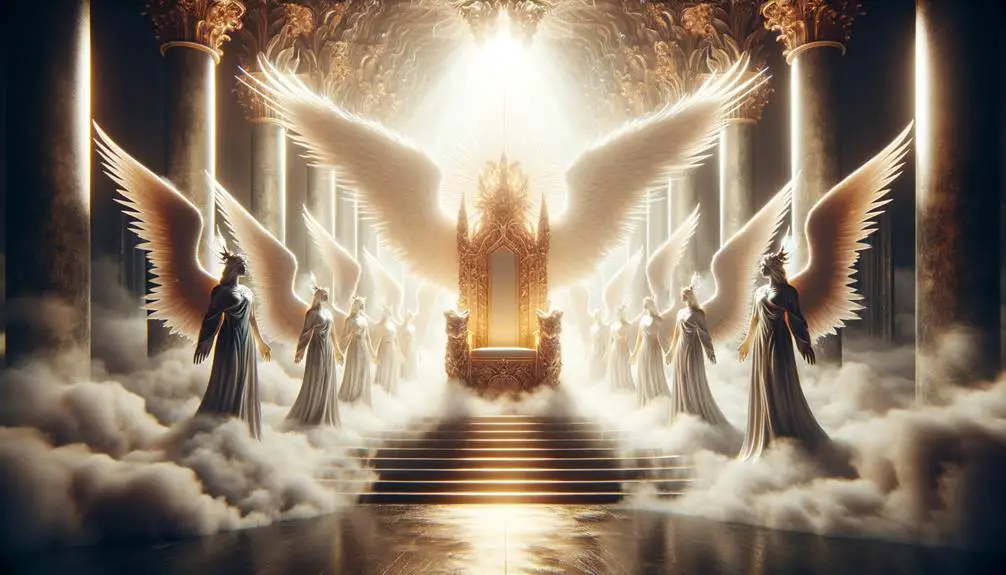
In Isaiah's vision of the Lord, as depicted in the Holy Throne Scene, you encounter a profound representation of divine majesty and authority.
The Seraphim's Purification Act symbolizes the cleansing and preparation necessary for entering into God's presence.
Lastly, Isaiah's Prophetic Commission underscores the transformative impact of this divine encounter, marking a pivotal moment in his ministry and message.
The Holy Throne Scene
Isaiah's vision, as recounted in the biblical text, unveils a majestic scene where he witnesses the Lord seated upon a high and exalted throne, surrounded by seraphim. This depiction is rich with symbols of divine ambiance and a structured angelic hierarchy, setting the stage for a profound theological narrative.
Consider the following elements:
- Angelic Hierarchy: The presence of seraphim, high-ranking celestial beings, underscores a complex angelic order serving around God's throne.
- Divine Ambiance: The setting conveys a sense of sacredness and awe, indicative of God's unparalleled majesty and holiness.
- Symbolic Representation: The throne scene serves as a powerful visual metaphor for God's sovereignty and glory, reinforcing the theme of divine kingship.
Analyzing this scene provides deep insights into the nature of divine-human interactions and the portrayal of divine majesty in biblical literature.
Seraphim's Purification Act
Having explored the majestic throne scene and the angelic hierarchy within it, we now turn our attention to a critical moment of divine-human interaction: a seraphim's act of purifying Isaiah. This scene, steeped in fiery imagery, underscores the seraphim's unique role within the angelic hierarchy.
As one of these celestial beings approaches Isaiah with a live coal, the symbolism of purification through fire becomes evident. This act not only cleanses Isaiah but also prepares him for his forthcoming prophetic commission. The seraphim's intervention highlights the intersection of the divine with the mortal, showcasing the necessity of purification before entering a holy service.
This moment serves as a pivotal juncture, illustrating the transformative power of divine purification within the context of a sacred calling.
Isaiah's Prophetic Commission
How does Isaiah's vision of the Lord, as described in the biblical narrative, mark a transformative moment in his prophetic journey?
Isaiah's initial reluctance to accept his calling is dramatically overcome in this pivotal scene. The vision not only signifies his commissioning but also sets the stage for the profound prophetic implications of his mission.
- Realization of Unworthiness: Isaiah's immediate acknowledgment of his own sinfulness and inadequacy.
- Divine Purification: The symbolic act of a seraphim purifying his lips with a coal, signifying his cleansing and preparation for the prophetic role.
- Acceptance of the Mission: Isaiah's eventual acceptance of his calling, 'Here am I; send me,' indicates his transformation and readiness to embark on his challenging prophetic path.
Ezekiel's Divine Visions
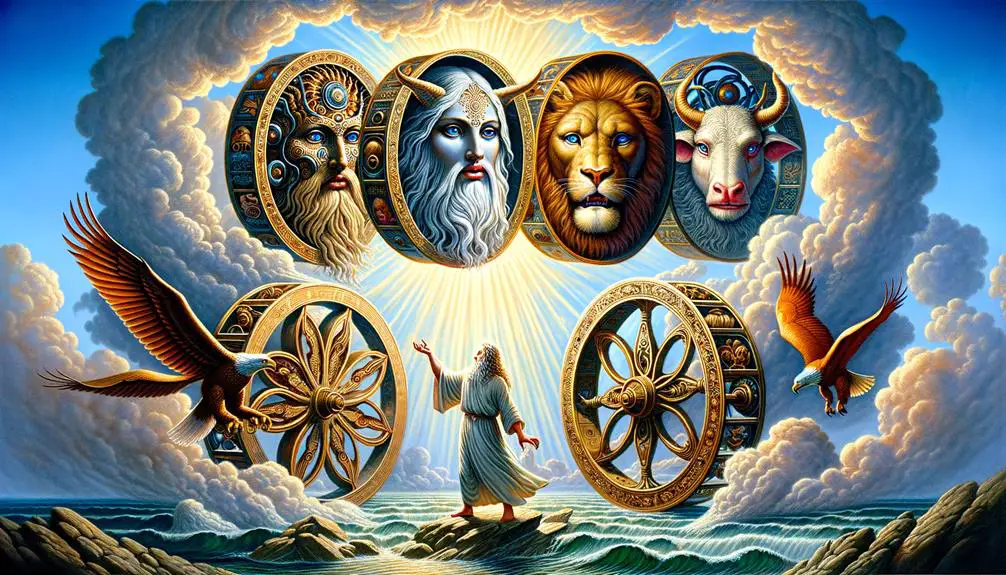
You encounter a profound shift in divine revelation as you explore Ezekiel's experiences, starting with his encounter with the Cherubim.
This vision, alongside the Glorious Throne Vision, marks a pivotal moment in biblical narratives of seeing God.
These episodes, together with the prophetic messages revealed, underscore the complexity and depth of Ezekiel's theological insights.
Ezekiel's Cherubim Encounter
In Ezekiel's account, the prophet's divine vision of cherubim epitomizes the complex interplay between celestial beings and human understanding within biblical narratives. This encounter isn't just a spectacle but a profound revelation with layers of meaning. Here's what you need to grasp:
- Cherubim Symbolism: Traditionally, cherubim represent guardianship and proximity to the divine. Their appearance in Ezekiel's vision underscores the sacred nature of the message being communicated.
- Vision Interpretation: Deciphering the symbolism offers insights into God's character and intentions, suggesting a multi-dimensional relationship with humanity.
- Theological Implications: This encounter challenges and expands contemporary understandings of divine-human interaction, urging readers to contemplate the nature of divine revelation and its impact on human spirituality.
The Glorious Throne Vision
Ezekiel's vision of the glorious throne, a pinnacle moment in biblical prophecy, unveils the majesty and sovereignty of God in a narrative rich with symbolic imagery.
This vision, steeped in divine mystery, showcases heavenly architecture that transcends human understanding, highlighting the profound otherness of the divine realm.
The visionary symbolism in Ezekiel's account serves not only as a testament to the overwhelming power and glory of God but also as a medium through which divine truths are communicated.
The intricate details of the throne and its surroundings reflect a complex theological understanding of God's presence and governance.
Through this vision, you're invited into a reflective exploration of divine sovereignty, as depicted through the elaborate symbols of heavenly architecture and the visionary symbolism that frames this celestial scene.
Prophetic Messages Revealed
Delving deeper into the prophetic landscape, Ezekiel's divine visions unfold complex messages that challenge and enlighten the contemporary understanding of divine communication. These visions, rich in symbolism, serve not only as historical records but also as timeless pieces offering divine warnings and spiritual guidance. To grasp their significance:
- Symbolism and Metaphor: Ezekiel's visions employ powerful symbolism to convey divine messages, making abstract concepts tangible.
- Divine Warnings: Through vivid imagery, these visions serve as dire warnings to the people, urging repentance and a return to spiritual faithfulness.
- Spiritual Guidance: Beyond warnings, they offer hope and guidance, outlining the path to spiritual renewal and a closer relationship with the divine.
Ezekiel's experiences thus bridge the gap between the divine and the mortal, offering insights that remain profoundly relevant.
The Transfiguration of Jesus
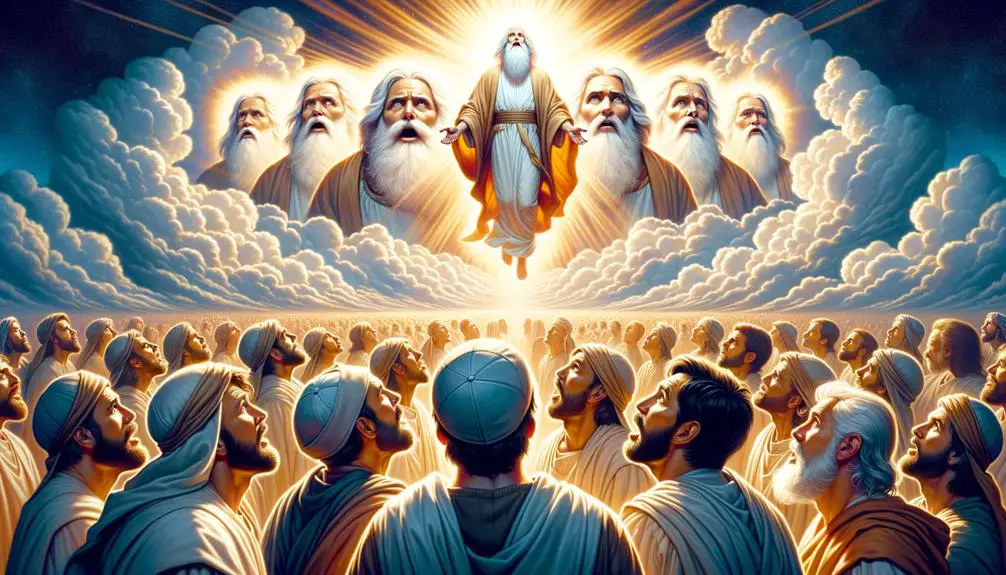
At the heart of New Testament theology, the Transfiguration of Jesus stands as a pivotal moment where divine nature and human experience intersect profoundly. This event, as narrated in the Synoptic Gospels, unfolds on Mount Tabor, offering a unique glimpse into the glorified state of Jesus. Here, you're not just encountering a historical or mystical event but a theological cornerstone that bridges the Old and New Testaments.
Mount Tabor becomes the stage for this divine revelation, where Jesus is transfigured before Peter, James, and John. His face shines like the sun, and his clothes become as white as light, presenting a visible manifestation of His divine nature. This moment isn't merely about the transformation of Jesus' appearance but signifies the fulfillment of the Law and the Prophets, evidenced by Elijah's presence alongside Moses. Elijah, representing the prophets, and Moses, symbolizing the Law, standing with Jesus, underscore the continuity and fulfillment of God's salvation plan through His Son.
Elijah's presence is particularly significant. It not only affirms Jesus' prophetic mission but also highlights the expected return of Elijah as a forerunner to the Messiah, a belief rooted in Jewish eschatological expectations. This convergence of the Law, the Prophets, and the Messiah in Jesus' transfiguration underscores the comprehensive nature of divine revelation, bridging past promises with their fulfillment in Christ.
The Transfiguration, therefore, isn't just an isolated miracle but a profound theological event that reaffirms Jesus' divine identity and mission, inviting believers to perceive the glory of God's nature revealed in Christ.
Stephen's Glimpse of Glory
In the Acts of the Apostles, you'll find Stephen's vision of glory, where he beholds God's presence, marking another significant theological moment that connects humanity with the divine. As the first Christian martyr, Stephen's faith and the vision he shares just before his death provide profound insights into the nature of divine revelation and the Christian experience of martyrdom.
Here are three crucial aspects of Stephen's glimpse of glory:
- The Martyr's Faith: Stephen, filled with the Holy Spirit, looks up to heaven and sees the glory of God, and Jesus standing at the right hand of God. This moment underscores the depth of Stephen's faith, as he remains steadfast and visionary even in the face of imminent death. His ability to see God's glory is a testament to his unwavering belief and commitment to his faith.
- The Vision Itself: Stephen's vision is unique because it's a direct and personal revelation of God's presence. Unlike other biblical figures who receive messages through angels or dreams, Stephen sees God's glory with his own eyes, emphasizing the immediacy and personal nature of his divine encounter.
- The Stoning Aftermath: The aftermath of Stephen's stoning, where he asks God to forgive his persecutors, echoes Jesus' own words on the cross. This act of forgiveness in the face of brutal martyrdom highlights the transformative power of divine revelation and the Christian call to love and forgive, even in the most challenging circumstances.
Stephen's glimpse of glory not only illuminates his martyr's faith but also offers profound theological insights into the nature of divine encounters and the Christian ethos of forgiveness and love in the aftermath of persecution.
John's Revelation Experience
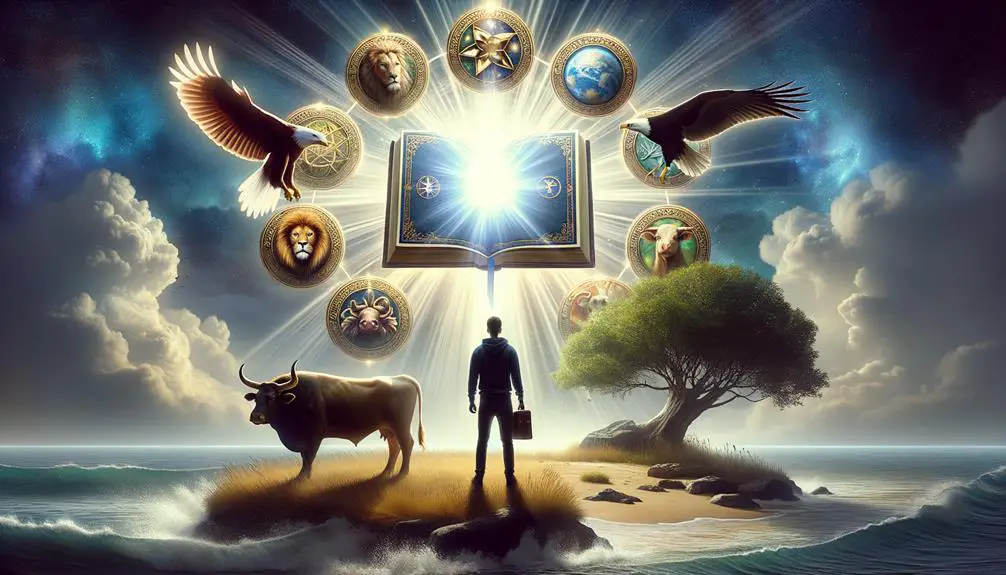
Moving from Stephen's earthly vision of divine glory, we now explore John's apocalyptic revelation, a profound and complex experience of God's ultimate revelation to humanity. Unlike the more direct encounters with the divine described earlier in biblical narratives, John's experience, as detailed in the Book of Revelation, is mediated through layers of apocalyptic symbolism and visions. This complexity requires a careful unpacking to understand the multifaceted ways God's presence and intentions are revealed.
Central to John's revelation are the Seven Seals, a series of prophetic visions that unfold a cosmic drama of judgment and salvation. Each seal, when broken, ushers in an aspect of God's plan for the end times, revealing His sovereignty over history and the ultimate triumph of good over evil. The symbolism here is dense and multifarious, pointing to the inevitable challenges of interpreting apocalyptic literature. Yet, through this symbolic veil, John's experience offers a unique lens on the nature of divine revelation itself—God's communication isn't always direct or easily understood, but it's purposeful and laden with meaning.
Analyzing John's apocalyptic revelation thus extends beyond mere narrative curiosity; it invites a deeper reflection on the nature of divine-human communication. The complexity and symbolic richness of John's visions challenge readers to engage with the text on multiple levels, unraveling the layers of meaning to discern the face of God amidst apocalyptic imagery. In this, John's experience serves as a compelling testament to the enduring quest for understanding God's ultimate revelation to humanity.
Theophanies in the Bible
Throughout biblical narratives, theophanies—manifestations of God to humans—serve as pivotal moments that reveal the divine character and intentions, offering profound insights into the nature of God's communication with humanity. These divine encounters, often marked by angelic appearances, underscore the transcendent and immanent aspects of the divine presence.
To delve deeper into the concept, consider these aspects of theophanies in the Bible:
- Nature of Divine Manifestations: Theophanies vary in form, ranging from thunderous voices and burning bushes to gentle whispers and angelic messengers. This diversity illustrates the multifaceted ways in which God chooses to reveal Himself, tailored to the context and the individuals involved. Angelic appearances, in particular, often serve as intermediaries, conveying messages of divine will and guidance.
- Purpose of Theophanies: These divine encounters aren't merely displays of power but are deeply purposeful. They often occur at critical junctures in biblical history, serving to initiate covenants, provide direction, or affirm God's promises. Through these manifestations, God establishes a relationship with humanity, guiding and shaping the course of events according to divine will.
- Impact on Recipients: Individuals who experience theophanies are profoundly transformed. These encounters serve as a catalyst for mission, calling recipients to action or to bear witness to God's power and sovereignty. The transformative nature of these experiences underscores the significant impact of divine-human interaction, fostering a deeper understanding and commitment to God's plans.
Analyzing theophanies within the biblical context provides valuable insights into the ways God communicates with humanity, revealing the depth and complexity of divine-human interaction through divine manifestations and angelic appearances.
Frequently Asked Questions
How Do Various Religious Traditions Interpret the Concept of Seeing God's Face, and What Theological Implications Does It Hold?
You're diving into the nuanced interpretations of divine visibility across religions, exploring how the concept of seeing God's face varies widely.
These interpretative differences reveal much about the theological implications within each tradition. Some view it as the ultimate spiritual attainment, while others see it symbolically, reflecting a deeper understanding or connection with the divine.
This analysis sheds light on the rich, complex fabric of belief and the human quest for the divine.
Are There Any Accounts Outside the Bible, in Other Religious or Historical Texts, That Describe Encounters Similar to Seeing God's Face?
Ironically, you're now seeking faces in tales beyond the Bible, as if divine encounters are hidden in every ancient nook. Archaeological evidence and cultural comparisons provide a fascinating lens. Through these, you'll find narratives across civilizations that echo such profound experiences.
Analyzing these accounts, one can't help but notice the universal yearning for the divine. These stories, steeped in tradition, offer rich, scholarly insight into humanity's ceaseless quest to see the face of the divine.
How Has the Depiction of Seeing God's Face in Art and Literature Evolved Over the Centuries?
In exploring how the depiction of seeing God's face has evolved in art and literature, you'll find a fascinating journey. Artistic representation has shifted from abstract, symbolic forms to more personalized, humanized portrayals.
Literature analysis reveals a parallel evolution, with early texts veering towards reverence and awe, gradually embracing more intimate, nuanced interpretations. This evolution reflects broader changes in societal attitudes towards divinity and the sacred, marking a significant shift in human consciousness.
What Psychological or Spiritual Significance Might Individuals Derive From the Metaphor of Seeing God's Face in Contemporary Religious Practice?
In contemporary religious practice, the metaphor of seeing God's face can signify divine intimacy and transformational encounters.
You might find that such vivid imagery isn't just about literal vision but reflects a deeper, spiritual awakening.
This notion suggests that experiencing a moment of profound connection or revelation with the divine can lead to significant personal growth and understanding, akin to a metaphorical face-to-face meeting with the essence of spirituality itself.
Can the Experiences of Seeing God's Face in the Bible Be Correlated With Modern-Day Mystical Experiences or Visions Reported by Individuals Across Different Cultures?
You might wonder if modern-day mystical experiences align with biblical accounts of seeing God's face.
By examining neuroscientific perspectives, you'll find that brain patterns during spiritual encounters can be similar across cultures.
Furthermore, the cultural symbolism attached to these visions varies, yet they often share core themes of transcendence and transformation.
This suggests a profound, universal aspect of human spirituality, bridging ancient texts and contemporary experiences.
Conclusion
In the biblical narrative, the divine is both veiled and unveiled, a paradox that captivates and mystifies.
You've journeyed through instances where mortals, from Moses to John, encountered God's presence, each experience unique yet bound by the common thread of transcendence.
These theophanies juxtapose the infinite with the finite, challenging our understanding of the divine-human interface.
Analyzing these encounters reveals not just historical or spiritual insights but also profound reflections on humanity's perpetual quest for the divine.

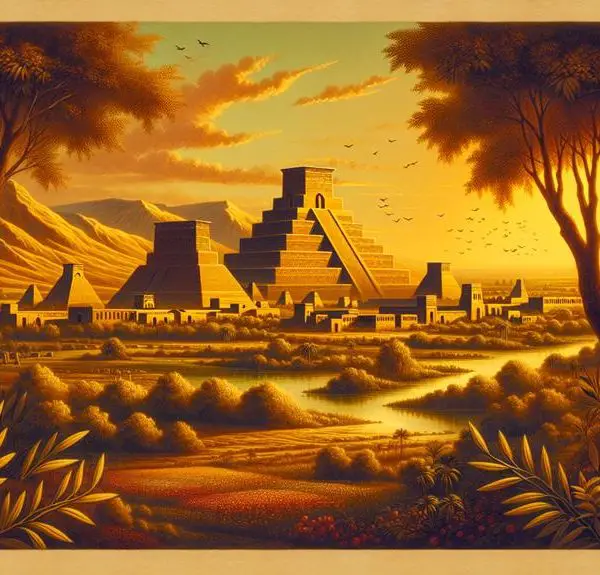

Sign up